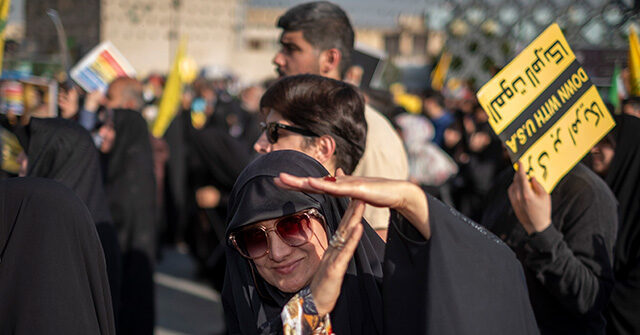A recent rally in Dearborn, Michigan, highlighted the notorious rhetoric of Hassan Nasrallah, the late leader of Hezbollah, culminating in a demonstration where attendees displayed his signature gesture. The event, dubbed “Stand with Lebanon,” took place outside the Dearborn Police Department, attracting significant attention due to the inflammatory slogans and sentiments echoed by the participants. Among the placards, one notably referenced a 2020 speech by Nasrallah in which he threatened U.S. troops, warning that they would return home “horizontally” — a euphemism for being repatriated in coffins. The rally underscored the ongoing tensions surrounding Hezbollah’s animosity towards American military presence in the Middle East.
In his chilling 2020 address, Nasrallah spoke specifically about retaliating against the American military following the assassination of Iranian General Qassem Soleimani. He made it clear that U.S. soldiers in the Middle East would face severe consequences and that their presence would not go unpunished. Emphasizing the danger to U.S. military personnel, he asserted, “The American military killed them… the one to pay the price.” This rhetoric propelled a narrative that encouraged violence against U.S. forces, culminating in his emblematic pronouncement about American soldiers returning “in horizontal positions.” His vehement assertions were echoed by the crowd at the rally, which chanted “Death to America,” reinforcing Hezbollah’s longstanding hostility toward the United States.
The implications of the rally are manifold, particularly in light of the reported presence of Al-Mayadeen News, a Hezbollah-affiliated media outlet. Known for promoting anti-Western narratives, its inclusion in the Dearborn demonstration raised concerns about the influence and infiltration of Hezbollah’s propaganda efforts in local communities. Dearborn’s demographics have made it a hotbed of anti-American sentiment, previously evidenced by viral videos of rallies where demonstrators shouted anti-U.S. and anti-Israel chants. These events have become increasingly contentious, provoking national debate over the rise of radicalism in American cities and the extent of support for terrorist organizations like Hezbollah.
Activists at the rally included prominent figures like teacher Tarek Bazzi, who defended the hostile sentiments expressed during previous protests. The rallies in Dearborn had been noted for over two decades as a “hotbed of hate,” where support for groups such as Hamas, Hezbollah, and Iran has been commonplace. This growing radicalization prompted reactions from organizations like MEMRI, with director Steven Stalinsky issuing statements that contextualize the rallies as manifestations of deep-seated anti-Western animus, particularly towards the United States and Israel.
Nasrallah, who led Hezbollah since 1992, was a significant figure in shaping the group’s operations and its military capabilities against Israel. His recent death in a targeted airstrike has heightened tensions in the region. Following his demise, Hezbollah’s retaliatory attacks have intensified, particularly after Hamas engaged in a deadly assault that left many Israelis dead. The aftermath of these events illustrates the ongoing volatility in Middle Eastern politics and the precarious position of U.S. interests there, leading to potential calls for further military support for Israel and containment strategies against Hezbollah.
Despite being designated a terrorist organization by numerous countries, including major Western nations, Hezbollah continues to garner support in various circles, as evidenced by rallies like the “Stand with Lebanon.” Political figures, including former President Trump and Senator Tom Cotton, have vocalized strong denunciations of Hezbollah and urged decisive action against its leadership. Amidst calls for military assistance to Israel and condemnation of terrorism, the fervent sentiment shown in Dearborn poses a broader question about societal divides in the U.S. and how emerging radical ideologies and foreign influences express themselves within local communities. Overall, the intersection of local protests and global conflicts brings to light complex dynamics that challenge national security and societal cohesion in the U.S.

